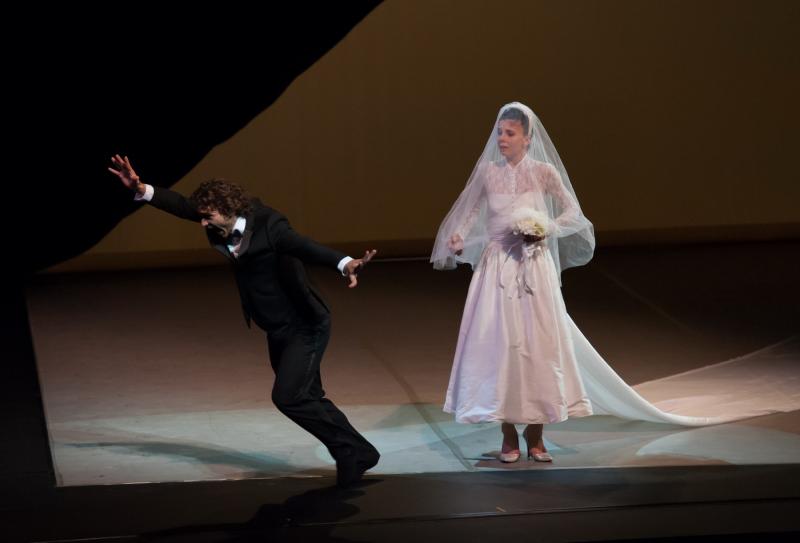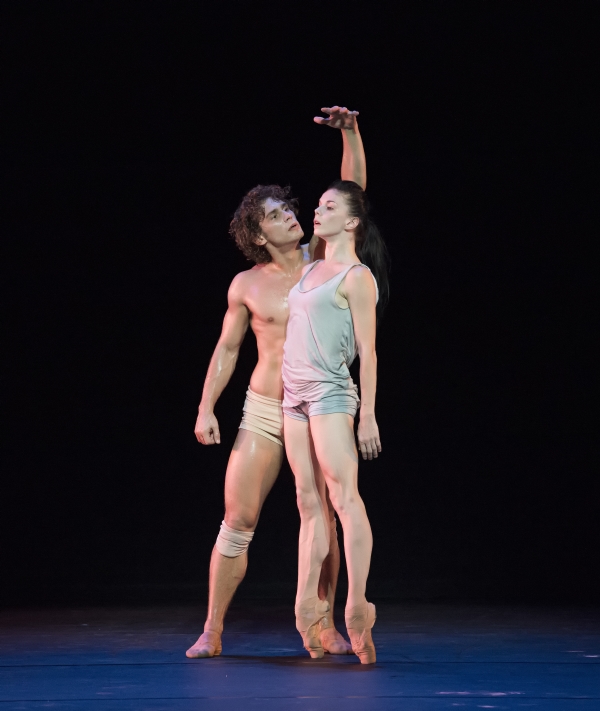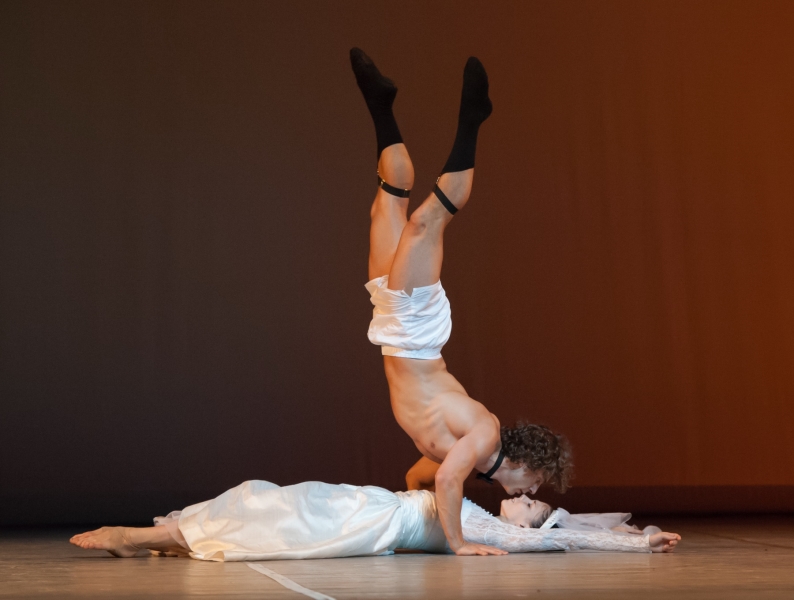Solo for Two, Osipova/Vasiliev, London Coliseum | reviews, news & interviews
Solo for Two, Osipova/Vasiliev, London Coliseum
Solo for Two, Osipova/Vasiliev, London Coliseum
Arthur Pita's black comedy makes up for greige tedium from Cherkaoui and Naharin

Mounting a contemporary dance show together doesn’t seem like the best way to get over your ex, even if you are (or rather, were) ballet’s most fabulously marketable couple.
The show they are mounting now is Osipova’s brainchild. Her determination and focus are truly remarkable: it’s a heck of an endeavour both to move sideways into contemporary dance and attempt to fill four shows at the Coliseum in August, when most other Royal Ballet principals are putting their feet up on the beach. At 27 and right at the top of her career as a ballerina, she doesn’t need to do this now. She’s a legend for her interpretation of the most traditional story ballet roles (Kitri, Giselle) - but evidently, like Sylvie Guillem, she wants to do more. Good on her. It’s just a touch unfortunate that, on the strength of the first two thirds of this bill, the “more” in question was that contemporary ballet staple, inscrutable duets in greige underwear.
 Sidi Larbi Cherkaoui has reworked a piece called Mercy he had made for Les Ballets de Monte Carlo. The opening (pictured right) is (literally) striking: Vasiliev directing a staccato barrage of hits at Osipova, whose stiff back and blank eyes as she allows Vasiliev’s “blows” (they never actually touch her body) to move her around are, frankly, terrifying. This is the set-up for the piece’s dubious relationship-redemption arc; it’s followed by a Vasiliev solo which suggests his unhappiness by contorting his powerful body on the floor – flipping him over, putting uncomfortable weight on his neck. Odd jumps and party tricks from his big ballet solos make for an incongruous addition here, but are just a more obvious indication of what was already apparent from the outset: that highly specialised classical ballet dancers do not become contemporary dancers overnight.
Sidi Larbi Cherkaoui has reworked a piece called Mercy he had made for Les Ballets de Monte Carlo. The opening (pictured right) is (literally) striking: Vasiliev directing a staccato barrage of hits at Osipova, whose stiff back and blank eyes as she allows Vasiliev’s “blows” (they never actually touch her body) to move her around are, frankly, terrifying. This is the set-up for the piece’s dubious relationship-redemption arc; it’s followed by a Vasiliev solo which suggests his unhappiness by contorting his powerful body on the floor – flipping him over, putting uncomfortable weight on his neck. Odd jumps and party tricks from his big ballet solos make for an incongruous addition here, but are just a more obvious indication of what was already apparent from the outset: that highly specialised classical ballet dancers do not become contemporary dancers overnight.
Cherkaoui’s choreography retains ballet elements – Osipova is in pointe shoes – but for Osipova and Vasiliev the transitions between those and the contemporary movement language more alien to their bodies too obviously requires a certain effort. Occasionally we get a striking moment – as when Osipova uses her feet, as flexible and intelligent as hands, to stroke an abject Vasiliev – but overall there’s very little to like in this awkward, borderline-abusive duet, except the rather fine singing of German Baroque songs from the pit.
Ohad Naharin, choreographer of the Israeli contemporary dance group Batsheva, has been much more ruthless about getting Osipova and Vasiliev to inhabit his physical language. The result, in Passo, is the striking and unexpected sight of two of the world’s most famous ballet dancers stuttering around on their knees, or trotting bent over, like children pretending to be mice. Naharin integrates their speciality moves – Osipova hurling herself into Vasiliev’s arms from several metres away – better into the story he is trying to tell, which also (yawn) seems to be about a relationship breaking down.
It’s unusual for a recording of someone singing Greensleeves to be an improvement, music-wise, but the piece does become markedly better when the booming static of the first half gives way to the song about lost love. It becomes even better when another folk song, wordless this time, takes over, and suddenly flashes of fire and humour enter the dancers’ relationship: the pace picks up, we get the hint of a dance-off in the rain, one then the other zips through an energetic sequence. Finally, some fun is had.
 But the vast majority of the fun on offer in the programme is concentrated in Arthur Pita’s piece, Facada, a terrific, very black comedy about a jilted bride. Pita succeeds because he plays to these dancers’ strengths: as well as their phenomenal physical abilities, what has always marked Osipova and Vasiliev out is their storytelling, both comic and tragic. Pita gives us Osipova in a white dress tripping buoyantly around the stage in delighted anticipation of her wedding, Vasiliev dancing his constricting tuxedo off after abandoning her at the altar, and a series of increasingly chilling interactions between them, as a deranged Osipova forces him to dance a loving duet, even moving his jaw to make him mouth a love song.
But the vast majority of the fun on offer in the programme is concentrated in Arthur Pita’s piece, Facada, a terrific, very black comedy about a jilted bride. Pita succeeds because he plays to these dancers’ strengths: as well as their phenomenal physical abilities, what has always marked Osipova and Vasiliev out is their storytelling, both comic and tragic. Pita gives us Osipova in a white dress tripping buoyantly around the stage in delighted anticipation of her wedding, Vasiliev dancing his constricting tuxedo off after abandoning her at the altar, and a series of increasingly chilling interactions between them, as a deranged Osipova forces him to dance a loving duet, even moving his jaw to make him mouth a love song.
After the grey monotony of the previous two pieces, it’s pure delight to see the two of them having fun together (pictured above left). There is an exciting frisson of horror involved in watching this story reach its violent denouement, and Osipova’s demented, exultant jig on Vasiliev’s “grave” is nothing short of thrilling for its intensity. Add in the pleasures of clever, effectively minimal designs by Jean-Mark Puissant, live Portuguese fado music by Frank Moon, and the fabulously laconic Elizabeth McGorian stalking about the stage as the cadaverous-but-glamorous Lady In Black, and you have half an hour of dance theatre so engaging, it was almost good enough to make up for the two damp squibs that preceded it.
- Solo for Two is at the London Coliseum until 9 August.
rating
Explore topics
Share this article
The future of Arts Journalism
You can stop theartsdesk.com closing!
We urgently need financing to survive. Our fundraising drive has thus far raised £49,000 but we need to reach £100,000 or we will be forced to close. Please contribute here: https://gofund.me/c3f6033d
And if you can forward this information to anyone who might assist, we’d be grateful.

Subscribe to theartsdesk.com
Thank you for continuing to read our work on theartsdesk.com. For unlimited access to every article in its entirety, including our archive of more than 15,000 pieces, we're asking for £5 per month or £40 per year. We feel it's a very good deal, and hope you do too.
To take a subscription now simply click here.
And if you're looking for that extra gift for a friend or family member, why not treat them to a theartsdesk.com gift subscription?
more Dance
 'We are bowled over!' Thank you for your messages of love and support
Much-appreciated words of commendation from readers and the cultural community
'We are bowled over!' Thank you for your messages of love and support
Much-appreciated words of commendation from readers and the cultural community
 R:Evolution, English National Ballet, Sadler's Wells review - a vibrant survey of ballet in four acts
ENB set the bar high with this mixed bill, but they meet its challenges thrillingly
R:Evolution, English National Ballet, Sadler's Wells review - a vibrant survey of ballet in four acts
ENB set the bar high with this mixed bill, but they meet its challenges thrillingly
 Like Water for Chocolate, Royal Ballet review - splendid dancing and sets, but there's too much plot
Christopher Wheeldon's version looks great but is too muddling to connect with fully
Like Water for Chocolate, Royal Ballet review - splendid dancing and sets, but there's too much plot
Christopher Wheeldon's version looks great but is too muddling to connect with fully
 iD-Reloaded, Cirque Éloize, Marlowe Theatre, Canterbury review - attitude, energy and invention
A riotous blend of urban dance music, hip hop and contemporary circus
iD-Reloaded, Cirque Éloize, Marlowe Theatre, Canterbury review - attitude, energy and invention
A riotous blend of urban dance music, hip hop and contemporary circus
 How to be a Dancer in 72,000 Easy Lessons, Teaċ Daṁsa review - a riveting account of a life in dance
Michael Keegan-Dolan's unique hybrid of physical theatre and comic monologue
How to be a Dancer in 72,000 Easy Lessons, Teaċ Daṁsa review - a riveting account of a life in dance
Michael Keegan-Dolan's unique hybrid of physical theatre and comic monologue
 A Single Man, Linbury Theatre review - an anatomy of melancholy, with breaks in the clouds
Ed Watson and Jonathan Goddard are extraordinary in Jonathan Watkins' dance theatre adaptation of Isherwood's novel
A Single Man, Linbury Theatre review - an anatomy of melancholy, with breaks in the clouds
Ed Watson and Jonathan Goddard are extraordinary in Jonathan Watkins' dance theatre adaptation of Isherwood's novel
 Peaky Blinders: The Redemption of Thomas Shelby, Rambert, Sadler's Wells review - exciting dancing, if you can see it
Six TV series reduced to 100 minutes' dance time doesn't quite compute
Peaky Blinders: The Redemption of Thomas Shelby, Rambert, Sadler's Wells review - exciting dancing, if you can see it
Six TV series reduced to 100 minutes' dance time doesn't quite compute
 Giselle, National Ballet of Japan review - return of a classic, refreshed and impeccably danced
First visit by Miyako Yoshida's company leaves you wanting more
Giselle, National Ballet of Japan review - return of a classic, refreshed and impeccably danced
First visit by Miyako Yoshida's company leaves you wanting more
 Quadrophenia, Sadler's Wells review - missed opportunity to give new stage life to a Who classic
The brilliant cast need a tighter score and a stronger narrative
Quadrophenia, Sadler's Wells review - missed opportunity to give new stage life to a Who classic
The brilliant cast need a tighter score and a stronger narrative
 The Midnight Bell, Sadler's Wells review - a first reprise for one of Matthew Bourne's most compelling shows to date
The after-hours lives of the sad and lonely are drawn with compassion, originality and skill
The Midnight Bell, Sadler's Wells review - a first reprise for one of Matthew Bourne's most compelling shows to date
The after-hours lives of the sad and lonely are drawn with compassion, originality and skill
 Ballet to Broadway: Wheeldon Works, Royal Ballet review - the impressive range and reach of Christopher Wheeldon's craft
The title says it: as dancemaker, as creative magnet, the man clearly works his socks off
Ballet to Broadway: Wheeldon Works, Royal Ballet review - the impressive range and reach of Christopher Wheeldon's craft
The title says it: as dancemaker, as creative magnet, the man clearly works his socks off
 The Forsythe Programme, English National Ballet review - brains, beauty and bravura
Once again the veteran choreographer and maverick William Forsythe raises ENB's game
The Forsythe Programme, English National Ballet review - brains, beauty and bravura
Once again the veteran choreographer and maverick William Forsythe raises ENB's game

Add comment